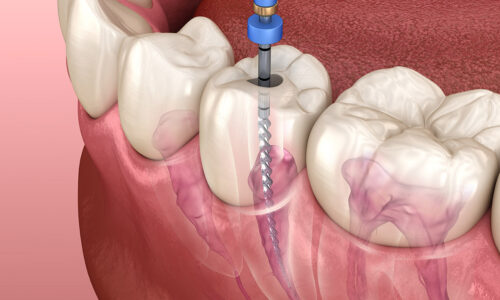Root Canal Procedure
What is Root canal treatment?
Root canal treatment or endodontic treatment is necessary when the centre part within the tooth, known as the pulp, housing the blood vessels, nerves and living connective tissues, becomes infected or inflamed. The root canal procedure is performed to save a damaged or badly infected tooth, instead of extracting it. This procedure is performed by an endodontist or a root canal specialist.
The most common causes of tooth damage or infection are, cavities occurring due to plaque accumulation, cracked or broken teeth due to any accidents or trauma, gum diseases, and repeated dental treatment to a particular tooth. These issues can cause pulp inflammation, infection and damage to the pulp irreversibly. The person will at times experience excruciating pain. The pain may subside when the pulp dies, but very often returns as the infection spreads. It is advisable to see a general dentist immediately if you experience a toothache or gum pain.
Hadapsar, Pune’s Leading Root Canal Centre –Root Canal in Kharadi.

Get your Dental treatment with single consultation.
The most common causes of tooth damage or infection are, cavities occurring due to plaque accumulation, cracked or broken teeth due to any accidents or trauma, gum diseases, and repeated dental treatment to a particular tooth. These issues can cause pulp inflammation, infection and damage to the pulp irreversibly. The person will at times experience excruciating pain. The pain may subside when the pulp dies, but very often returns as the infection spreads. It is advisable to see a general dentist immediately if you experience a toothache or gum pain.
How is the root canal procedure done?
- The entire root canal procedure may take place in one sitting, or at times 2 or 3 sessions depending on the condition of the tooth. Each sitting may last between 30 – 90 minutes. It is a simple procedure with relatively little or no discomfort. At the outset, local anaesthesia is administered to the tooth which is to be treated.
- After the tooth and the surrounding areas become numb, the endodontist drills an opening through the crown or the biting surface of the tooth to access the pulp chamber. If it is a front tooth, the endodontist drills an opening from behind the tooth.
- Using special files the endodontist cleans out the infected, diseased and dead pulp from the canals. The procedure does not cause any pain as the area is numb due to the anaesthesia, and the tissue that is removed is dead.
- Once all the infected and dead tissue is removed, the canals are disinfected using disinfectants.
- The canals are then shaped with fine instruments so that they can be filled with the root canal fillings known as gutta-percha and sealed. During the process of shaping, the irrigation method is used to wash and clean the canals and remove the debris, before inserting the fillings and sealing the tooth.
- A temporary cover material which acts as a seal is placed above the gutta-percha. This covering material is kept in place till a crown or a cap which looks like a normal tooth is fitted atop the treated tooth.
- At times, a post is inserted into the canal next to the gutta-percha to give the crown more support.
- Thereafter, the crown is cemented in place so that it never dislodges.
Are there any side effects of the root canal procedure?
- A common side effect of root canal treatment is a dull pain in the tooth following the procedure. It usually vanishes within a week after the treatment.
- However, if any bacteria remains even after the procedure, the infection may begin again. Therefore, it is advisable to go to the doctor if the pain stops after a few days of the procedure and recurs again.
- At times there could be a crack at the root of the tooth, which does not get noticed by the endodontist. If so, the crack leaves the area exposed to bacteria and infection.
- The crown may come to loose which will expose the treated tooth. If left exposed the seal on the tooth may erode leaving the way for bacteria to enter and infect the tooth again.
- If the crown dislodges, you need to get it fixed at your dentist’s immediately.
- If defective materials are used during the filling process, they may erode which may lead to bacterial infection again.
Are there any post-treatment guidelines after a root canal procedure?
The post-treatment guidelines of root canal treatment include:
- Take the antibiotics as advised by the dentist.
- Maintaining good oral hygiene is extremely important, with regular brushing and teeth flossing.
- It is advisable to not eat or drink anything for a couple of hours after root canal treatment. Since the treated area is numb, there are chances of accidentally biting your teeth or tongue while eating. You can eat after the numbness wears off.
- Avoid hard and crunchy foods for a few days after a root canal treatment.
- If the opening on your teeth has been filled with temporary filling, chances are that some of the filling may wear off in between appointments. If the entire filling wears off you need to consult your dentist immediately.
We Provide services Tooth Coloured Filling